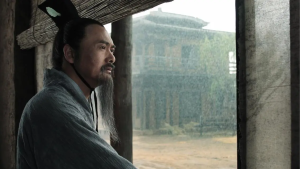Forgotten Rescue: Why Do Chinese Care About British POWs?
At 30°13’47” North latitude and 122°45’55” East longitude, in the waters of the Zhoushan Archipelago in Zhejiang, at least 843 British individuals rest in eternal peace. This is the location where the “Lisbon Maru” sank.
Zhoushan today stands as a vital port city in China, boasting an international port. The Ningbo-Zhoushan Port leads globally in annual cargo throughput and ranks third in container throughput. By 2023, its per capita GDP is projected to surpass $25,000, solidifying its position as one of the fastest-growing cities in the Yangtze River Delta region in terms of economic development.
The recently released documentary film “The Sinking of The Lisbon Maru” reveals this long-buried history. In October 1942, the Japanese military commandeered the “Lisbon Maru” passenger and cargo ship to transport over 1,800 British prisoners of war. While passing through the waters near Zhoushan, the ship was torpedoed by an American submarine, leading to the rescue of 384 British prisoners by hundreds of Zhoushan fishermen on sampans.
 Poster for the documentary film “The Sinking of the Lisbon Maru”
Poster for the documentary film “The Sinking of the Lisbon Maru”
Today, the Chinese fishermen and British veterans who witnessed this history have all passed away, but their stories are worth recording and remembering.
The Sunken Japanese Prisoner of War Ship
In 2015, 86-year-old Zhoushan fisherman Liang Yijuan recalled to reporters one of the proudest moments of his life, which was rescuing three British individuals under the watchful eyes of the Japanese.
“On October 2, 1942, as the day was breaking, we, the common folks of Qingbang Island, heard a loud bang from the east,” said Lin Agen, five years older than Liang Yijuan, recalling the scene of that day. At that time, he was working on the mountainside and, upon hearing the bang, he looked up and saw a large ship on the eastern sea with its bow raised and its stern gradually sinking.
 The red marker indicates the location of the sinking of the Lisbon Maru in the waters near Zhoushan
The red marker indicates the location of the sinking of the Lisbon Maru in the waters near Zhoushan
Qingbang Island, located in the East China Sea, is a small island in the largest archipelago of China, the Zhoushan Archipelago, more than ten nautical miles eastward, along a busy international shipping route.
The Chinese fishermen who heard the bang discovered that the sunken ship was not a commercial vessel but a Japanese prisoner of war ship transporting British prisoners.
The 7,152-ton “Lisbon Maru” prisoner of war ship, carrying 1,816 British prisoners of war and civilians, 778 Japanese soldiers and passengers, and 1,676 tons of cargo, departed from the Sham Shui Po Pier in Hong Kong on the morning of September 27, 1942.
After the fall of Hong Kong on December 25, 1941, with 15,000 British troops surrendering, the prisoners on board this ship accounted for one-tenth of the British troops stationed in Hong Kong.
The “Lisbon Maru” set off eastward from Hong Kong, passing by the Dongdao Lighthouse at the northern tip of Taiwan, the Beiyu Mountain Lighthouse in Xiangshan County, Ningbo. The prisoners on the ship were emaciated and plagued by diseases.
According to survivors’ recollections, each cargo hold housed around 600 people. The front hold near the bow confined Royal Navy personnel, the second hold housed the Royal Scots, Middlesex Regiment, Royal Engineers, Royal Signal Corps, and Royal Medical Corps, while the third hold at the stern contained the Royal Artillery. The overcrowded holds had no space, no light, no sense of time, with sweat, body odor, vomit, and excrement making the air stifling.
Around 7 a.m. on October 1, the “Lisbon Maru” was hit by a torpedo launched by the American submarine USS Grouper, responsible for disrupting Japanese naval traffic. Existing records confirm that the “Lisbon Maru” did not display the required Red Cross markings as per international conventions.
After being hit, the “Lisbon Maru lost power and drifted at sea. In the afternoon of the 1st, Japanese warships arrived and took away most of the Japanese individuals, leaving a small number of guards to watch over the prisoners on deck.
At that time, British prisoners were locked in three stuffy, dirty, and dim lower holds. Before the Japanese retreated, they nailed the hatches shut with boards, covered them with waterproof cloth, and tightly bound them with ropes. The torpedo-hit section of the “Lisbon Maru” was at the stern, and the British prisoners in the third hold had to take turns desperately hand-pumping water out of the ship, while prisoners in other holds were already falling ill and dying.
The loud bang on October 2 signaled the end of the fate of the “Lisbon Maru.” The British prisoners in the second hold began to fight for survival. They broke through the hatch, rushed to the deck, and then went to rescue their comrades in the first and third holds. The British prisoners in the third hold were too weak and slow to act, compounded by a broken ladder leading to the hatch. Out of over 600 individuals, only around 200 made it to the deck, and over 400 perished first.
However, the surviving British prisoners who managed to escape did not anticipate the horrifying scene that followed: the Japanese soldiers opened fire! The leading officer who rushed to the deck was either killed or injured, and the British prisoners who jumped into the sea to escape were shot at. Some prisoners tried to climb onto the Japanese rescue boats, only to be ruthlessly kicked back into the water.
Risking their lives to rescue and provide shelter
At the moment when British prisoners of war were struggling desperately, Chinese fishermen, dressed in tattered clothes, with dark skin and slender figures, extended a helping hand from their rudimentary wooden fishing boats.
Lin Agen recalled, “It happened to be a northeasterly wind that day, just when the tide was rising. We saw many foreigners with blonde or red hair drifting over from the sunken ship, so we quickly rowed out to rescue them.”
In addition to Qingbang Island, all the fishermen from Miaozihu Island, where the Dongji Town government is located, mobilized. A total of 198 fishermen from the two islands used 46 small fishing boats on 65 trips to rescue 384 British individuals.
“At that time, the common people were poor, using small wooden boats that couldn’t row quickly. They could only make two round trips in one morning. Some British individuals were not rescued in time and were swept away by the ebbing tide,” Lin Agen said regretfully.
 On October 20, 2019, descendants of the British prisoners of war from the “Lisbon Maru” expressed their gratitude to the late fisherman Lin Agen who participated in the rescue efforts in Zhoushan.
On October 20, 2019, descendants of the British prisoners of war from the “Lisbon Maru” expressed their gratitude to the late fisherman Lin Agen who participated in the rescue efforts in Zhoushan.
Lin Agen remembered that the situation took a turn later on. Seeing the Chinese fishermen lending a hand in rescue efforts, perhaps fearing that their plan to shoot the prisoners might be exposed, the Japanese military changed their minds and began salvaging the prisoners.
British POW Han Meixun (who later served as Deputy Assistant Political Officer in the Hong Kong British Government) angrily criticized in his post-war memoir that the Japanese originally intended to let the British drown at sea, so they could shift the blame to the Americans. It was not until the Chinese fishermen arrived to rescue them that the Japanese changed their minds.
Throughout the entire World War II period, the Japanese military’s mistreatment of prisoners of war was extremely heinous. 25% of Allied prisoners of war died from abuse while constructing the “Thai-Burma Death Railway,” and nearly 20% of prisoners of war died from abuse during the infamous “Bataan Death March.” Additionally, at least 843 individuals drowned on the “Lisbon Maru,” accounting for nearly 50% of the total, making it another tragic “death march at sea.”
Former Secretary-General of the Chinese WWII History Research Association Peng Xunhou stated, “Many historical facts, including the Nanjing Massacre, prove that Japanese militarism’s treatment of prisoners of war was even more cruel and heinous than that of the German Nazis. The Japanese military had 24 hours to transfer the prisoners on the ‘Lisbon Maru,’ but they chose not to save them, another atrocity in their mistreatment of prisoners of war.”
 In mid-October 1942, a group photo was taken in Zhoushan featuring Evans, Fallon, Johnston, and Chinese soldiers and civilians.
In mid-October 1942, a group photo was taken in Zhoushan featuring Evans, Fallon, Johnston, and Chinese soldiers and civilians.
After the 384 rescued British prisoners of war landed on the small island, some of them displayed Chinese signs reading “Hong Kong British.” The fishermen then realized that they were distressed British individuals and offered them dry clothes to change into, as well as rice, dried fish, and sweet potatoes from their own homes to alleviate their hunger.
At that time, rice was a precious food item for the chaotic Chinese fishermen. Lin Agen mentioned that they mainly ate sweet potatoes, and many of them suffered from severe stomach issues as they aged.
“I was a child at the time, running to others’ homes to watch the commotion. The British individuals couldn’t use chopsticks, only spoons. One British person had a beard, and I boldly went up to touch it. He didn’t get angry, just smiled and patted my head,” Liang Yijuan said.
He recalled that on Qingbang Island, some British individuals lived in fishermen’s homes, while others stayed in the Temple of the Heavenly Empress. The worship of the Heavenly Empress was widespread among Chinese fishermen, as she was considered their protector at sea.
On the second day of rescuing and sheltering the British prisoners of war, several Japanese planes flew over the area of the sunken ship and bombed it. On the morning of the 4th day, five warships sailed from Zhoushan Island and quickly surrounded Qingbang Island and Miaozihu Island. Over 200 Japanese soldiers landed on the islands to search for British prisoners of war, beating Chinese fishermen and ordering them not to hide the British individuals.
Liang Yijuan could never forget the scene: At 2 p.m. on October 4, 1942, 381 British soldiers were taken aboard a Japanese ship, tearfully waving goodbye to the Chinese fishermen as they departed.
These 381 British prisoners of war, along with hundreds of others salvaged by the Japanese, were sent to labor camps in Kobe and Osaka, Japan. Over 200 individuals died in the camps, and only after Japan’s defeat in the war were these British prisoners of war rescued and sent back to their home country.
Even under strict Japanese surveillance, three British individuals miraculously managed to hide. They were Naval Lieutenant Fallon, businessman Evans, and diplomat Johnston. Liang Yijuan remembered that the fishermen hid them in a cave by the sea.
Later, the three British individuals were secretly rowed back to the mainland by the fishermen, eventually reaching wartime capital Chongqing, China. These “surviving” British prisoners of war were able to expose the atrocities of the Japanese military to the world through radio broadcasts.
Liang Yijuan said that the cave was discovered by him and two friends while playing. It was surrounded by the sea on three sides, with huge rocks forming cliffs all around, creating gaps due to weathering and erosion.
From concealment to relocation, not a single Chinese person went to inform on them.
“The fishermen in Zhoushan have always held the belief that even if there are three generations of grievances between us, I will still save you if you fall into the sea,” said Liang Yindi, the daughter of Liang Yijuan. “This is the fishermen’s simple moral code, not only to save lives but also to recover bodies.
Reunion Half a Century Later
Many of the fishermen who participated in the rescue of the “Lisbon Maru” were illiterate, did not understand English, and did not know the names of the people they had saved. However, the story of their brave rescue of British prisoners of war was passed down from generation to generation on Dongji Island.
Before leaving, the British prisoners of war gave some items to the fishermen of Dongji Island. These items, such as the two square tiles with four circular patterns engraved inside and an English sentence in the home of fisherman Yan Quanmin, a silver Western-style dining knife in the home of Ren Furen, a harmonica in the home of Zhang Fuqing, and a ring engraved with “JNW9.375” in the home of Liu Zhuding, were treasured by the fishermen for generations, documenting the friendship between the two nations.
 The English soldier’s ring.
The English soldier’s ring.
“In the leisure time after dinner, the elderly would always tell stories to the children,” said Liang Yindi, the daughter of Liang Yijuan. Liang Yijuan often mentioned that the bearded British men gestured their height before leaving, indicating they would meet again once the children grew taller. However, since then, the rescued British prisoners of war did not meet the Chinese fishermen again, until 2005 when British veteran Charles Jordan returned to Dongji Town to mourn his fallen comrades.
On August 18, 2005, 63 years after the sinking of the “Lisbon Maru,” Charles Jordan arrived with his wife, two sons, and relatives of the deceased to Dongji Island. They laid flowers on the sea where the “Lisbon Maru” sank, embracing their benefactors tightly. Jordan’s visit further spread the story of the “Lisbon Maru” incident.
 On August 18, 2005, Charles Jordan (far left) embraced the elderly fisherman Chen Yonghua, who participated in the rescue during the “Lisbon Maru” incident.
On August 18, 2005, Charles Jordan (far left) embraced the elderly fisherman Chen Yonghua, who participated in the rescue during the “Lisbon Maru” incident.
“Back then, the poor fishing village was filled with low, small houses, and now there are so many high-rise buildings, what a great change,” even though they couldn’t communicate verbally, tears filled the eyes of Jordan and the fishermen. Jordan presented a special gift to the fishermen – a rectangular frame containing five black-and-white photos of himself from childhood to youth before joining the army, with a colored photo in the bottom right corner showing Jordan with his children and grandchildren in a family portrait.
Jordan shared that he swam in the water for a full 10 hours before being rescued by the Chinese fishermen, and because of this experience, he persistently insisted that his children learn how to swim. He felt deeply grateful to be able to return alive to his hometown, despite often having nightmares and being plagued by the terrifying memories of war.
Jordan’s son, Alan, said, “My father told me about these experiences, and he was very happy to have the opportunity to return to China, to visit the lifesavers from years past in Zhoushan. He said it was because of the desperate efforts of the Chinese fishermen back then that he survived.”
Since 2005, the Dongji Town government has compiled historical materials, fishermen’s oral histories, rescue lists related to the “Lisbon Maru” maritime disaster, and on May 1, 2009, opened the Dongji Museum, showcasing a wealth of historical materials and objects related to the “Lisbon Maru” incident.
Today, in the special collection room of the Zhejiang Provincial Archives, there is still a set of historical archives numbered L030-236, formed 67 years ago. In these archives, the British government expressed gratitude to the Dongji fishermen and offered donations and gifts. The government of Dinghai County, which then administered Dongji Township, responded by saying that the Dongji fishermen’s actions were a moral obligation, and they did not seek rewards for their deeds.
 The list of rescuers from the “Lisbon Maru” compiled by the local government in 1948.
The list of rescuers from the “Lisbon Maru” compiled by the local government in 1948.
The Chinese people demonstrated great righteousness between life and death.
As the last fisherman involved in the rescue, Lin Agen, passed away, the descendants of the British prisoners of war sent their condolences and gratitude, saying, “He left a legacy to the world, including courage, heroism, and kindness shown by a person in the face of the worst atrocities of humanity.”



